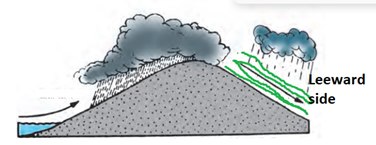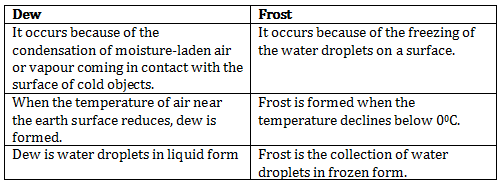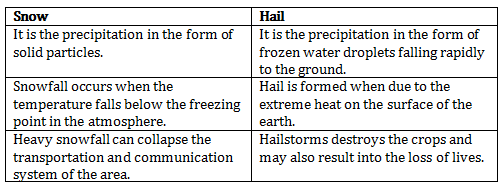Class 9 MAHARASHTRA STATE TEXTBOOK BUREAU Solutions Social Studies Chapter 5 - Precipitation
Precipitation Exercise 48
Solution 1(a)
Rainfall
Solution 1(b)
Fog
Solution 1(c)
Hail
Solution 1(d)
Snowfall
Solution 2(a)
Convectional rainfall
Precipitation Exercise 49
Solution 2(b)
Orographic rainfall
Solution 2(c)
Cyclonic rainfall
Solution 3(1)
The windward side is receiving more rainfall.
Solution 3(2)

The rain shadow region in the above figure is the side getting less rainfall. It is called the leeward side.
Solution 3(3)
Figure A shows the occurring of the convectional type of rainfall while figure C shows the cyclonic rainfall.
Solution 3(4)
Stormy winds and floods are associated with the cyclonic rainfall.
Solution 3(5)
Convectional type of rainfall occurs in Singapore. It is because it lies in the equatorial region. Places located in the equatorial region experience convectional type of rainfall.
Solution 4(1)
Acid rainfall. It occurs when rainwater becomes acidic in nature due to the presence of sulphuric acid and nitric acid in the atmosphere.
Solution 4(2)
Dew is the odd one out because it is not a form of precipitation. It is the tiny drops of water that form on cool surfaces at night, when atmospheric vapor condenses.
Solution 4(3)
Odd one out is a measuring jar. Thermometer (use for measuring temperature), anemometer (use for measuring wind speed) and rain guage (use for measuring rainfall) measure the different elements of weather unlike a measuring jar.
Solution 5(1)
The heat of the Sun evaporates water resulting in the formation of water vapour. When the water vapour cools down, it condenses and form clouds. It is from clouds that the water precipitates in the form of rainfall, hail, snow etc.
Solution 5(2)
A rain shadow area is an area of a land that lies on the leeward side (area that does not face the winds) of a mountain. High mountains act as barriers for the winds. When winds strike the mountains, it causes rainfall on the windward side (side of the mountain facing the winds). By the time, the winds go on to the leeward side, it (winds) had already shed much of its moisture. Hence, the rain shadow area receives scanty rainfall.
Solution 5(3)
Orographic occurs in most parts of the world. Convectional rainfall occurs only in particular regions. Cyclonic rainfall is also limited to a few areas. Orographic rainfall occurs when winds strike a mountain or a high landform. Since the mountains cover 22% of the land, the orographic rains occurs in most parts of the world.
Solution 5(4)
If condensation occurs closer to the earth's surface, fog, dew or frost is seen.
Fog: The temperature of the layers of the air near the surface of the earth reduces. As temperature reduces, water vapour condenses. In this process, vapour turns into microscopic water particles and float in the air. When the density of these droplets in the air increases, fog occurs.
Dew: When moisture-laden air near the earth's surface comes into contact with very cold objects, condensation of the vapour takes place. They turn into very small water droplets which then stick to the surface of the cold objects. This is called dew.
Frost: If the temperature of the air is less than 00C, the water droplets stuck to the surfaces of cold objects freeze. This frozen water droplet is called frost.
Solution 5(5)
- The instrument that is used to measure rainfall is called rain gauge.
- The funnel i.e. used for measuring rain has a specific diameter and the rain falling in this funnel is collected in bottle fitted in the gauge.
- The collected water is then measured with the help of measuring jar. In the areas of heavy rainfall, the reading of the rain with rain gauge should be taken every three hours. The measuring jar reads rain in millimetres
- The gauge has to be kept on open ground on 30cm high flat-mount so that the rain water is collected without any obstruction.
Solution 6(1)

Solution 6(2)


